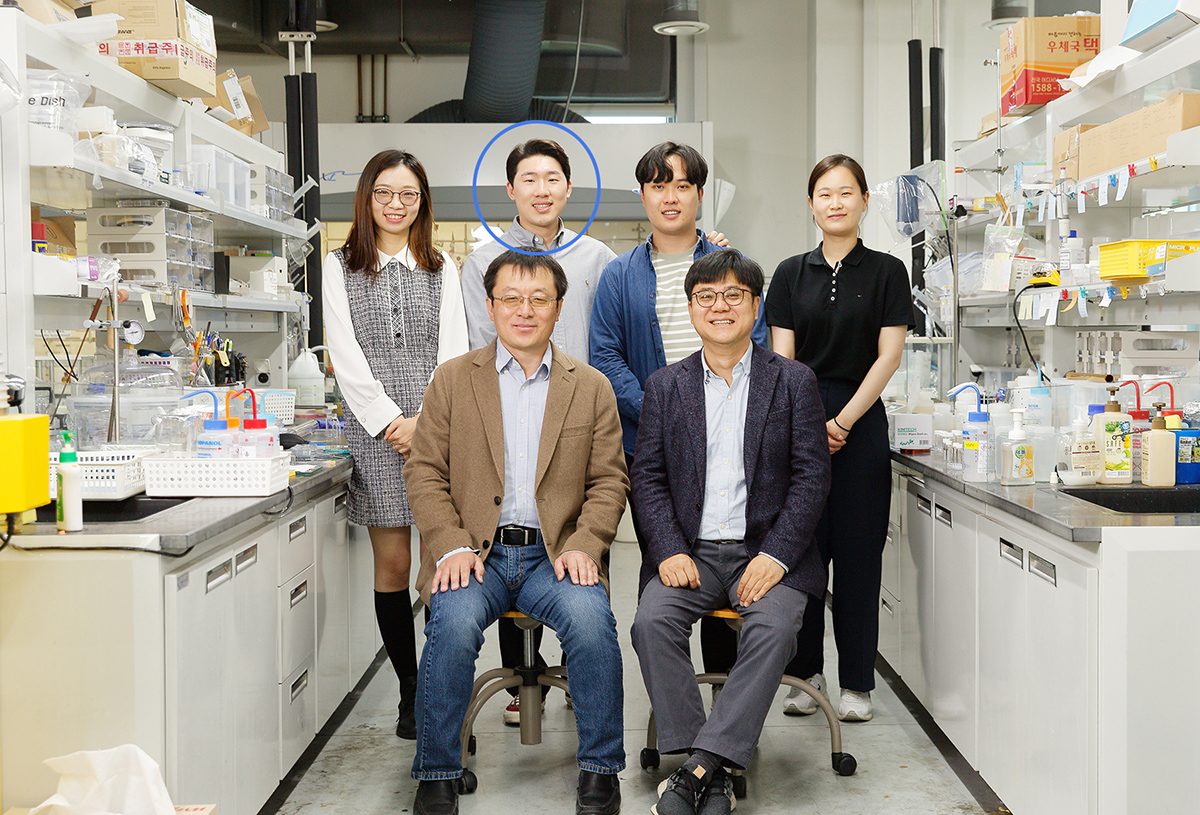커뮤니티
부경투데이
- 국립 부경대학교의 다양한 모습과 소식을 접하시면 부경대학교가 한번 더 가까워집니다.
| 동문이 뛴다 | UNIST 연구원 마경열 동문(Our alumnus Ma Kyung-Yeol, a researcher at UNIST) | |||
| 작성자 | 대외협력과 | 작성일 | 2022-06-10 |
| 조회수 | 912 | ||
| 동문이 뛴다 | UNIST 연구원 마경열 동문(Our alumnus Ma Kyung-Yeol, a researcher at UNIST) | |||||
 |
대외협력과 |  |
2022-06-10 |  |
912 |
부경대 동문, 차세대 고집적 반도체 핵심 소재 기술 개발
- UNIST 신현석 교수팀 마경열 연구원 … 제1저자로 <네이처> 논문 게재

△ 마경열 동문(뒷줄 왼쪽에서 두 번째)이 연구팀과 기념촬영하고 있다.
UNIST에서 연구원으로 활동하고 있는 부경대학교 동문이 참여한 연구가 세계적 학술지인 <네이처(Nature)>에 실렸다.
UNIST 신현석 교수(화학과) 연구팀의 마경열 연구원(부경대 재료공학과 08학번)이 제1저자로 참여한 차세대 반도체 핵심 소재 기술 개발 연구성과가 지난 6월 2일 국제학술지 <네이처>에 게재된 것.
부경대 재료공학과를 2014년 졸업한 마경열 동문은 UNIST에서 박사학위를 마친 뒤 연구원으로 활약 중이다.
이번 연구는 차세대 고집적 반도체에 적용하기 위해 육방정계 질화붕소(hBN) 단결정을 여러 층으로 합성하는 기술을 세계에서 처음으로 개발한 것이다.
2차원 소재로 이루어진 차세대 고집적 반도체는 전류누설, 발열 등의 문제를 해결하고 집적도가 높지만, 전하 트랩이나 전하 산란과 같은 기능 저하를 막을 수 있는 2차원 절연체 소재가 꼭 필요하다.
육방정계 질화붕소가 이 같은 기능 저하를 막을 수 있는 유일한 2차원 절연체 소재로 알려져 있는데, 이를 반도체 소자에 쓸 수 있을 만큼 적절한 두께를 갖는 단결정 형태로 합성하는 기술 개발이 난제였다.
마경열 연구원 등 UNIST 연구팀은 이번 연구에서 합성에 필요한 재료의 농도를 조절하는 새로운 합성방식으로 두께 조절이 가능한 육방정계 질화붕소 단결정을 합성해냈다.
단결정을 다층 박막 형태로 합성한 것은 이번이 처음으로, 연구팀은 이 연구가 무어의 법칙(2년마다 반도체 칩의 미세소자 집적도가 2배씩 증가한다는 법칙)의 물리적 한계를 극복할 수 있을 것으로 기대하고 있다.
한편 부경대는 이보람 교수(물리학과)의 차세대 디스플레이 소재 PeLED 관련 연구가 지난해 <네이처>에 게재된 데 이어 졸업생의 연구성과가 <네이처>에 실리는 등 우수한 성과를 내고 있다. <부경투데이>
PKNU alumnus developed core material technology for next-generation high-density semiconductors
- Ma Kyung-Yeol, a researcher affiliated to prof. Shin Hyeon-Suk's team at UNIST... a thesis in <Nature> as the first author
Research conducted with an alumnus of Pukyong National University, who is a researcher at UNIST, was published in <Nature>, a world-famous academic journal.
The research results on the development of next-generation semiconductor core material technology in which researcher Ma Kyung-Yeol (enrolled in '08, major of materials engineering, PKNU) of the professor Shin Hyeon-Suk (chemistry)'s research team at UNIST participated as the first author was published in the <Nature>, international journal on June 2nd.
Our alumnus Ma Kyung-Yeol, who graduated from the department of materials engineering at Pukyong National University in 2014, became a researcher after completing his doctorate at UNIST.
This research is the first in the world to develop a technology to coalesce a single-crystals of hexagonal boron nitride (hBN) into multi-layers for application to next-generation high-density semiconductors.
The next-generation high-integration semiconductor made of two-dimensional materials solves problems such as current leakage and heating problem and has a high degree of integration, but a two-dimensional insulator material that can prevent functional degradation such as charge trapping or electron scattering is essential.
Hexagonal boron nitride is known as the only two-dimensional insulator material that can prevent such functional deterioration, but it was difficult to develop a technology to to coalesce it into a single-crystal form with an appropriate thickness for use in semiconductor devices.
In this study, the UNIST research team, including researcher Ma Kyung-Yeol, succeeded in synthesizing a hexagonal boron nitride single-crystal with adjustable thickness through a new synthesis mode that controls the concentration of materials required for synthesis.
This is the first time that a single-crystal has been synthesized in the form of a multi-layered thin film, and the research team expects that this study will overcome the physical limitations of Moore's Law (the number of transistors in a dense integrated circuit double about every two years).
Following the publication of professor Lee Bo-Ram (dept. of physics)'s research on PeLED, a next-generation display material, in <Nature> last year, Pukyong National University is producing excellent results, with the research results of its graduates being published in <Nature>. <Pukyong Today>